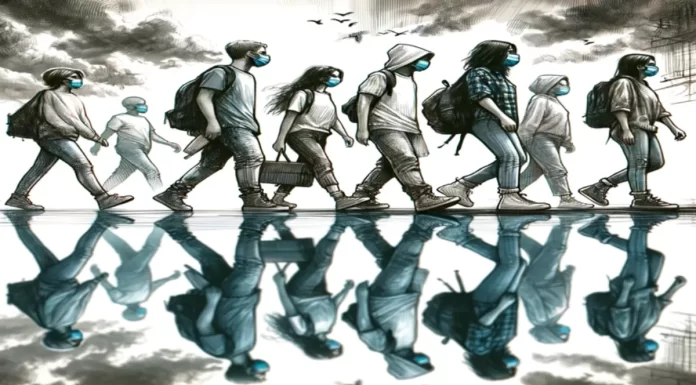The COVID-19 pandemic highlighted the issues concerning migrant workers for the first time—an area not previously addressed comprehensively by policymakers in India. The lack of adequate employment opportunities at their place of residence results in the migration of individuals or families to other areas (urban) or states where there is specific or seasonal demand (e.g., labour for crop cutting in Punjab). Migration of labour largely fulfills gaps in skilled and unskilled workers based on supply and demand criteria.
The process of migration is complex and may result from one or more factors, such as inequality in wages, better or more employment opportunities, social, economic, cultural, political, and spatial issues. In some states, migration is also due to “replacement factors” as the required workforce in those states has moved either within or outside the country. This may be due to low wages in the agriculture sector or seasonal agricultural failures.
There is also rural-urban migration, a normal trend in any country. Migration is crucial for the growth and development of individuals as well as the economic development of the areas where it takes place and is inevitable in countries like India. However, migration poses a number of challenges, as migrants are generally treated as “invisible” and “outsider” workers, and the conditions in which they work are often pathetic. Lack of occupational safety, discrimination at work, and unsafe working conditions are some of the general concerns of migrant workers, irrespective of the sectors or geographies in which they work. In any crisis—social, economic, political, or natural calamities like COVID-19—migrant workers are the ones who suffer the most.
It is important to promote the integration and inclusion of migrant workers into the socio-economic environment of the concerned area or state. Most migration of workers occurs in the unorganised or informal sector and involves the poor, marginalised, and weaker sections of society. These issues should be a major concern for policymakers in India. The state can play an important role in ensuring safe migration, decent living conditions, awareness about rights, preventing exploitation, and providing social welfare, including support during exigencies, crises, or job loss.
During the COVID-19 period, a massive reverse migration from the “destination” to the “origin place” took place across the country. For the first time, the state realised the gravity of the migrant population and the issues they face or can face. Lockdowns, loss of employment due to the closure of units or activities, social distancing norms, and other measures enforced by the state prompted a chaotic and painful process of massive return of migrants in India.
In some cases, the state appeared helpless and became a mere spectator due to unpreparedness in dealing with such an unprecedented situation or crisis. The major areas of work that migrants were engaged in include agriculture labour, brick kilns, construction sites, services (maids, watchmen, drivers), industrial non-skilled workers, and small and tiny roadside businesses (tea shops, dhobis, small eateries, hotels, restaurants, etc.). This migration was a matter of concern for the industry due to uncertainty about their return.
The government tried to resolve the issues of migrant workers by announcing a “free ration scheme” and other short-term measures, but these were not sufficient to address all the concerns of the migrant workers. Some of the steps taken by the government were:
- One Nation One Ration Card
- A special credit facility to support around 50 lakh street vendors
- States to fund food and shelter facilities for migrant workers
- Mahatma Gandhi National Rural Employment Guarantee Act (MGNREGA) for job creation in India's hinterland to provide employment to migrant workers moving back to their villages
- Pradhan Mantri Garib Kalyan Package (PMGKP) for three months, with amounts being transferred to Jan Dhan Accounts of women only
- Ration to poor families for three months
- Free gas cylinders for three months to poor families covered under the Pradhan Mantri Ujjwala Yojana
The government also launched the registration of labour on the E-Shram portal to create a single database. So far, about 30 crore people have been registered on this platform and issued E-Shram cards.
The government has also started upskilling these labourers through the NSDC's Recognition of Prior Learning (RPL) programme. Despite these efforts, there is now an urgent need to design and develop a comprehensive policy framework to address the issues of migrant workers on a long-term basis, including steps that need to be taken in crisis situations like COVID-19.
Main Issues of Migrant Workers
These include their engagement being informal and usually short-term or temporary, lack of facilities for accommodation, lack of awareness about government schemes and programmes, unequal wage distribution compared to local labour, no health benefits or schemes, lack of suitable job loss compensation or other risk mitigation mechanisms, and the non-availability of an agency or structure to address the concerns of migrant labour. There is no mechanism or standard operating procedure (SOP) to address any crisis situation at their place of work. Migrant workers are unorganised and therefore lack bargaining power compared to organised workers.
The desire and need for a comprehensive policy framework to look into the short-term and long-term issues concerning migrant workers cannot be ignored, given the sheer number of people or families affected by any crisis—economic or otherwise—that impacts the well-being of the workforce. Out of the 1.3 billion Indians, more than 450 million work in the informal economy and aspire to move to formal jobs.
A significant percentage of these are migrants from different parts of the country, typically from villages in the North and North-East, who migrate to tier-1 cities in search of a better life. They work as security guards, delivery staff, drivers, retail staff, carpenters, plumbers, housekeeping, factory workers, construction workers, etc. The construction sector employs a large number of migrant workers.
Many of them work on a “daily wage” basis and move from one place to another (work site) in search of jobs. Some are engaged by intermediaries to provide labour for large projects in both the state and private sectors. The imperfections in the labour market for migrants significantly impact their living and working conditions, necessitating state intervention. Some areas requiring policy intervention are:
Insurance Scheme for Wage Loss
One lesson learned from the migrant labour problems during COVID-19 is that those engaged in jobs lack insurance cover for job loss. If there had been a scheme to cover job loss—providing a subsistence amount for every worker, irrespective of whether they are in the organised or unorganised sector, for a period of three to six months—the issue of migration would have been substantially addressed.
For farmers, there is the Prime Minister Fasal Bima Yojna (PMFBY) to protect against income loss due to natural calamities. Similarly, there is a need to design an insurance scheme for all workers for job loss due to natural calamities, which may include the closure of companies or units due to economic or other crises such as pandemics. This scheme could be called the PM Job Security Scheme and implemented on the pattern of PMFBY. The labourer or employee would be eligible for a maximum of six months' salary or wages (not exceeding the minimum wages prescribed for that category).
The premium would be borne by the employee, employer, and state and central governments. The state government already collects cess for Building and Construction Workers (BOCW) under the Building and Other Construction Workers Act 1996 and could pay the premium from that. Such a scheme would mitigate the hardship of job loss due to various calamities or crises.
Health Coverage for All Migrants – Extending ESI to Informal Labour
All migrant workers should be covered under ESI, and the eligibility criteria should be relaxed. Currently, only formal sector labour or employees are covered under ESI. The premium required for covering migrant workers under ESI could be paid by the employer, cess collected, and/or the state and central governments. Even the Ayushman scheme could be extended to all migrant workers to meet their health needs, but the best option is to cover them under ESI. ESI is more comprehensive and meets all health expectations of migrant workers and their families.
MNREGA and Other Rural Development/Agriculture Scheme Integration to Meet Immediate Needs
Migrant workers who have returned to their villages can be engaged in various government schemes promoting wage employment. MNREGA is the main scheme, but other departments can also pool their resources to provide wage employment to every eligible worker during their stay in the village.
No migrant labourer should be denied wage employment. Though the government has provided funds for MNREGA, a mechanism should be built to fix the responsibility of district officials so that no worker is denied wage employment. MNREGA guidelines should permit individual economic activities rather than only community projects.
Activities such as beekeeping, mushroom cultivation, organic farming, fishery, and vegetable cultivation, which are short-gestation activities, should be permitted under MNREGA. This would not only provide wage employment but also help in income-generating activities. Labourers would get emotionally and socially engaged with a source of income for their families, and local administration should be made responsible to ensure this.
All eligible migrant workers can be covered under the PMAY scheme. MNREGA wage employment could be allowed for building or repairing houses by migrant labourers. This would engage them in constructive activity and create a permanent asset for their families. Individual house construction or repair should be permitted under MNREGA.
Job Works at Village Level – Atmanirbhar Bharat
It has been noticed that similar skilled persons, such as tailors, have moved to one village or block in large numbers. There is a need to create the desired infrastructure in these locations where there is a significant number of workers. Factory owners may be interested in outsourcing job works to such skilled manpower.
The government could provide infrastructure—sheds, power, machines—required by these workers. Workers could form SHGs or societies and be enabled to tie up with job work providers from the private sector. Even the industry could be incentivised to outsource job work to such workers' SHGs.
The government should play an active role in this. SHG clusters of workers at the village level, supported by the industry through job works, could be transformative and fulfil the objective of “Gram Swaraj.” Industrial units could adopt such clusters, supported by the government through various incentives.
Institutional Framework for Migrant Workers
Although labour departments in various states and at the central level look after the interests of migrant workers, there is no specific agency to promote their welfare and protect their interests. For building and construction workers, there is a board at every state level, and the cess collected is available to such boards, but the impact has not been very significant in improving the quality of life or dealing with crisis situations like job loss for workers.
There is a need to make these boards more encompassing—covering every migrant worker—or set up a separate board for migrant workers in every state. With large-scale employment in the e-commerce and similar sectors—gig workers—a separate “Board for Migrant Workers” in every state, with appropriate facilities or branches, like the Ex-servicemen Welfare Officer in every district, mainly in states where migration is more prevalent, would provide the desired sustainable institutional framework to address migrant workers' concerns.
Organising the Migrant Workers – Permitting/Promoting Unions
Promoting unions for migrant workers would support enhancing their bargaining skills, improve working conditions, reduce exploitation, and enable access to government schemes and programmes.
Over time, these unions would become the fulcrum for transformation in the lives and living conditions of migrant workers. Specific sectoral issues or other emerging socio-economic considerations due to changes in technology, etc., could also be highlighted by such unions to the concerned authorities for seeking their support and intervention.
The manifestos released by political parties do not mention any policy for migrant workers, despite their significant impact on the state apparatus during COVID-19. This is largely because migrant workers are unorganised and lack a forum to promote their interests. Despite these constraints, it is essential for the state to design and formulate effective policies to address the concerns of migrant workers and promote an institutional framework to support them in every aspect.








